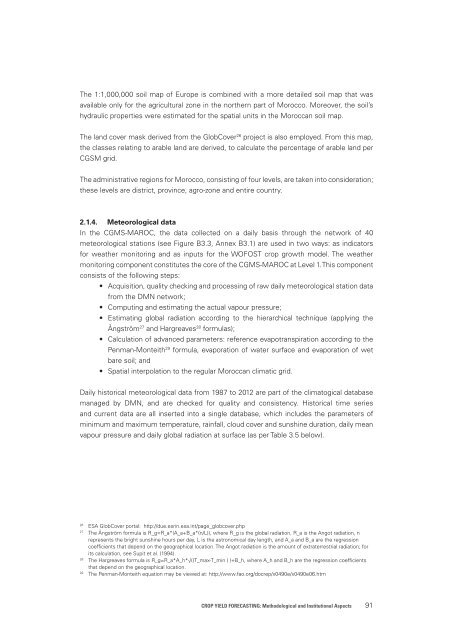Crop Yield Forecasting
1qKZxmS
1qKZxmS
Create successful ePaper yourself
Turn your PDF publications into a flip-book with our unique Google optimized e-Paper software.
The 1:1,000,000 soil map of Europe is combined with a more detailed soil map that was<br />
available only for the agricultural zone in the northern part of Morocco. Moreover, the soil’s<br />
hydraulic properties were estimated for the spatial units in the Moroccan soil map.<br />
The land cover mask derived from the GlobCover 26 project is also employed. From this map,<br />
the classes relating to arable land are derived, to calculate the percentage of arable land per<br />
CGSM grid.<br />
The administrative regions for Morocco, consisting of four levels, are taken into consideration;<br />
these levels are district, province, agro-zone and entire country.<br />
2.1.4. Meteorological data<br />
In the CGMS-MAROC, the data collected on a daily basis through the network of 40<br />
meteorological stations (see Figure B3.3, Annex B3.1) are used in two ways: as indicators<br />
for weather monitoring and as inputs for the WOFOST crop growth model. The weather<br />
monitoring component constitutes the core of the CGMS-MAROC at Level 1. This component<br />
consists of the following steps:<br />
• Acquisition, quality checking and processing of raw daily meteorological station data<br />
from the DMN network;<br />
• Computing and estimating the actual vapour pressure;<br />
• Estimating global radiation according to the hierarchical technique (applying the<br />
Ångström 27 and Hargreaves 28 formulas);<br />
• Calculation of advanced parameters: reference evapotranspiration according to the<br />
Penman-Monteith 29 formula, evaporation of water surface and evaporation of wet<br />
bare soil; and<br />
• Spatial interpolation to the regular Moroccan climatic grid.<br />
Daily historical meteorological data from 1987 to 2012 are part of the climatogical database<br />
managed by DMN, and are checked for quality and consistency. Historical time series<br />
and current data are all inserted into a single database, which includes the parameters of<br />
minimum and maximum temperature, rainfall, cloud cover and sunshine duration, daily mean<br />
vapour pressure and daily global radiation at surface (as per Table 3.5 below).<br />
26<br />
ESA GlobCover portal: http://due.esrin.esa.int/page_globcover.php<br />
27<br />
The Ångström formula is R_g=R_a*(A_a+B_a*(n/L)), where R_g is the global radiation, R_a is the Angot radiation, n<br />
represents the bright sunshine hours per day, L is the astronomical day length, and A_a and B_a are the regression<br />
coefficients that depend on the geographical location. The Angot radiation is the amount of extraterrestrial radiation; for<br />
its calculation, see Supit et al. (1994).<br />
28<br />
The Hargreaves formula is R_g=R_a*A_h*√((T_max-T_min ) )+B_h, where A_h and B_h are the regression coefficients<br />
that depend on the geographical location.<br />
29<br />
The Penman-Monteith equation may be viewed at: http://www.fao.org/docrep/x0490e/x0490e06.htm<br />
<strong>Crop</strong> <strong>Yield</strong> <strong>Forecasting</strong>: Methodological and Institutional Aspects 91


